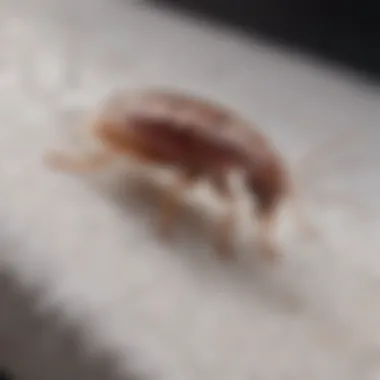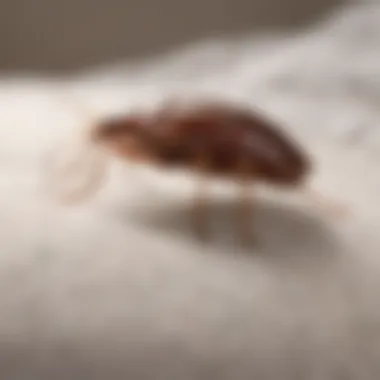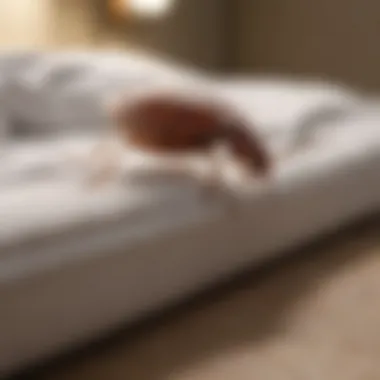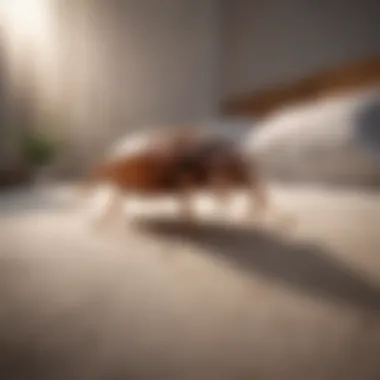Mastering Effective Strategies for Bed Bug Extermination


Intro
Bed bugs have become a significant concern for homeowners, affecting not just sleep quality but also mental well-being. Understanding their nature is paramount for effective extermination. This guide delves into the essential strategies for managing and eliminating bed bug populations. Knowledge about how to identify these pests is crucial. Furthermore, treatment options will be discussed in detail, along with preventive measures to ensure future infestations are avoided.
The increasing resistance of bed bugs to chemical treatments complicates their control. An integrated pest management strategy, which combines various removal techniques and an understanding of bed bug biology, can optimize results. Hence, this article is aimed at homeowners and professionals alike, offering practical insights into combating these resilient pests.
Design Inspiration
Although design inspiration generally refers to aesthetic choices, the approach to bed bug extermination can be seen as utilitarian design. There are certain methods to consider that not only lead to effective results but also minimize disruption to your living environment.
Trending Styles
In bed bug management, the trend leans towards integrated pest management (IPM). This method balances various techniques for extermination. Key elements include:
- Regular Inspection: Check sleeping areas for bites or signs of bed bugs.
- Proper Laundering: Heat treatment of fabrics is a favored approach. Items that can withstand high temperatures should be washed and dried.
- Decluttering: Minimize hiding spots during the extermination process.
Color Palettes
While color palettes are typically related to visual aesthetics, understanding the biology of bed bugs and their behavior can influence practical choices in your home. Light, open spaces are less favorable environments for them. Incorporating functional storage solutions may also limit their potential hiding places.
Practical Tips
Successfully exterminating bed bugs requires methodical and proactive strategies. Below are some useful tips to consider.
Maintenance & Care
- Vacuum Regularly: Keep your space clean. A thorough vacuuming of carpets, furniture, and along baseboards eliminates eggs and nymphs.
- Seal Cracks: Caulk and seal potential entry points around doors and windows to deter bed bugs.
- Inspect Second-hand Items: Check new acquisitions for bed bugs before bringing them into your home.
Budgeting & Planning
Setting a budget for bed bug extermination is crucial. Professional services can be expensive, but attempting to manage an infestation without expertise can lead to more costs. Keep in mind:
- DIY Treatments: Consider using heat or cold treatments where applicable. High-temperature steamers are particularly effective, but their initial cost may be a factor.
- Professional Extermination Services: Compare prices and ensure the service you choose has a solid track record of success with bed bug removal.
"An integrated strategy is essential for effective bed bug management. Combining various tactics improves the likelihood of complete elimination."
Understanding Bed Bugs
Understanding bed bugs is crucial for effectively eliminating them from your living space. This section provides insights into their biology and behavior, which form the foundation of successful extermination efforts. By knowing how bed bugs live, reproduce, and hide, one can develop smarter strategies for prevention and treatment.
Biology and Behavior
Life Cycle of Bed Bugs
The life cycle of bed bugs consists of several stages: egg, nymph, and adult. They lay eggs in hidden places, and these eggs hatch within one to two weeks. This rapid reproduction means that even small infestations can quickly escalate into larger ones. A notable characteristic is that bed bugs can survive for months without feeding, allowing them to persist in environments for long periods. This resilience makes understanding their life cycle particularly relevant for homeowners seeking to eradicate these pests. The unique feature of their lifecycle being so adaptable can be seen as a disadvantage when tackling an infestation, as failure to disrupt the life cycle at any stage can lead to recurring problems.
Feeding Habits
Bed bugs are hematophagous, meaning they feed solely on blood. Their feeding habits are crucial to their survival and reproduction. Adult bed bugs typically feed every five to ten days, generally at night. They inject saliva that contains anticoagulants to facilitate blood flow during a meal. This characteristic not only enables them to increase their blood intake but also leads to bites that can cause itching and allergic reactions. One unique aspect is that they can detect carbon dioxide and heat, which helps them locate hosts. Understanding these feeding habits aids in identifying the conditions that might foster their presence, which is essential when implementing treatment strategies.
Habitat Preferences
Bed bugs prefer warm, dark locations that are close to their hosts. Common habitats include seams of mattresses, cracks in walls, and behind furniture. Their preference for such places complicates detection efforts, as they often remain hidden during the day. This trait makes it vital to conduct thorough inspections when infestations are suspected. A key unique feature of their habitat choices lies in their ability to thrive in various environments, from homes to hotels. Therefore, recognizing these habitat preferences is a core part of knowing how to approach preventative measures and treatment options effectively.
Signs of Infestation
Detecting bed bugs early is essential for effective extermination. Being able to identify clear signs of an infestation can prevent a small problem from becoming a major issue.
Identifying Bites


Identifying bites is one of the first signs homeowners may notice. These bites often appear as small, red, itchy welts. They are typically clustered in groups of two or three. This aspect of bites serves as a helpful indicator, alerting individuals to the possible presence of bed bugs before they might see any actual bugs. One unique feature is that reactions can vary from person to person; some may not show any signs, making it easier for an infestation to go unnoticed.
Spotting Evidence
Spotting evidence of bed bugs includes looking for dark stains on sheets or mattresses, which are fecal spots left behind after feeding. Other signs include shed skins and tiny eggs. This characteristic of their evidence can help in identifying and confirming the presence of bed bugs. Understanding how to spot these signs before they become more prominent is essential. A unique aspect of this is that proactive inspections can save time and reduce the cost of extermination efforts.
Common Hiding Places
Common hiding places provide crucial clues in detecting bed bug infestations. They prefer to stay close to sleeping areas, including bed frames, headboards, and within bedding. Notably, this characteristic allows for targeted inspections. Knowing where to check can substantially improve the chances of successful removal. The unique feature of these hiding spots also highlights the need for vigilance in places like hotels or shared living spaces, where the risk of encountering bed bugs is higher.
Initial Inspection
The initial inspection is a critical step in the bed bug extermination process. Understanding the extent of the infestation is key to determining the best course of action. A detailed inspection allows homeowners to identify not only the presence of bed bugs but also the areas severely affected. This understanding helps in selecting the most effective treatment options.
Several elements are important during this phase. First, recognizing the signs of bed bugs can lead to quicker action and more effective control measures. Second, it helps in documenting findings, which is crucial for ongoing monitoring and evaluation of the treatment effectiveness.
Conducting a Thorough Search
Using Tools for Detection
Using tools for detection involves employing specific instruments that can aid in finding bed bugs more efficiently. Tools such as flashlights, magnifying glasses, and specialized bed bug detection kits are available. The major contribution of these tools lies in their ability to enhance visibility and ease detection. A flashlight, for instance, can illuminate dark areas where bed bugs like to hide.
The key characteristic of these detection tools is their simplicity and accessibility. They are often affordable and easy for homeowners to use. This makes them a popular choice for initial inspections. Their unique feature is that they empower individuals to take charge of their environment. However, they do have limitations; not all hidden bed bugs will be found, especially in complex spaces.
Examining Furniture and Fabrics
Examining furniture and fabrics is essential as these items are primarily where bed bugs reside. Thorough examination helps in pinpointing the most infested areas in a home. The key characteristic of this process is its direct approach, which allows for immediate action following detection. Homeowners can often see signs of bed bug activity, such as dark stains or shed skins.
This method is beneficial as it can often yield quick results. The unique feature of examining fabrics is that it can reveal not just adult bed bugs but also eggs and nymphs. However, a thorough examination can be laborious, and sometimes, it may require moving heavy furniture, which can be a deterrent for some.
Inspecting Travel Gear
Inspecting travel gear is an important step in preventing the spread of bed bugs. Bed bugs are notorious hitchhikers. They can latch onto clothing, suitcases, and personal items. This aspect contributes significantly to overall prevention strategies. The key characteristic of this inspection is that it occurs before items enter the home, which can help mitigate potential infestations.
The unique feature of checking travel gear is its proactive nature. It encourages a habit of vigilance, especially after traveling. Importantly, this practice can prevent internal home infestations from external sources. However, it can also become tedious, particularly if a person travels frequently.
Documenting Findings
Keeping a Record of Locations
Keeping a record of locations helps in maintaining a clear history of where potential infestations have been observed. It is vital for assessing the severity of the problem over time. The main contribution of this practice is that it helps organize information about infestations and allows for a better understanding of how they spread.
This method is beneficial in that it provides a clear path for follow-up inspections and actions. The unique aspect of keeping this record is that it serves as a valuable tool for strategizing future preventative measures. One disadvantage may be the need for diligence in updating records regularly, which not everyone may find easy.
Mapping Out Infested Areas
Mapping out infested areas involves creating a visual representation of the locations where bed bugs have been found. This is essential because it provides a clear overview, assisting both homeowners and professionals in visualizing the extent of the problem. The main characteristic of this approach is that it condenses data into an easily digestible format.
This method proves beneficial in targeted treatments since it allows for more precise application of extermination methods. The unique feature of mapping is that it can be used as a reference for future inspections or treatments. However, it can be time-consuming and may require some level of skill in tracking changes in the infestation patterns.
A thorough initial inspection lays the groundwork for effective bed bug control. By understanding their hiding places and documenting findings, homeowners increase their chances of successful extermination.
Treatment Options
The discussion of treatment options for bed bug extermination is crucial for effective management and elimination of these pests. This section highlights various methods that homeowners can adopt, focusing on both chemical and non-chemical strategies. It is essential to consider that a combination of methods often leads to better results, as bed bugs can be resilient. Understanding treatment options allows individuals to select the best course of action suited to their specific situations and environments.
Chemical Treatments
Chemical treatments are one of the most commonly employed methods in pest control. Their effectiveness largely depends on the types of insecticides used, how they are applied, and the precautions taken during their use.


Types of Insecticides
There are several types of insecticides available for bed bug control. The most popular types include pyrethroids, neonicotinoids, and insect growth regulators.
- Pyrethroids: These are synthetic versions of naturally occurring insecticides found in chrysanthemum flowers. Their key characteristic is their fast action against bed bugs, which makes them a favored choice. However, bed bugs can develop resistance to these chemicals over time, presenting a potential drawback in long-term management.
- Neonicotinoids: These work on the nervous system of the insects, effectively disrupting their behavior and lifecycle. They are considered beneficial as they can be effective even against resistant pests, although costs may be higher.
- Insect Growth Regulators (IGRs): IGRs don't kill bed bugs outright but inhibit their development. This unique feature is important in preventing infestations from growing, but they often need to be part of a broader integrated strategy.
Application Techniques
The way insecticides are applied is as critical as the types used. Different application techniques can influence their efficacy.
- Spraying: This is a common method where insecticides are applied directly to surfaces where bed bugs are likely to hide. This method is beneficial for immediate knock-down but requires precise targeting of infestation areas.
- Dusting: Using insecticide dust allows for treating cracks and crevices where sprays might not penetrate as effectively. Dust can remain effective for longer periods, making it a popular choice among exterminators.
- Fumigation: This is a more comprehensive but costly option. It involves sealing the whole area and introducing insecticides in gas form. While effective for widespread infestations, it requires professional handling and caution.
Safety Precautions
Safety is paramount when dealing with chemical treatments. Specific precautions must be observed to protect both people and pets in the home.
- Personal Protective Equipment: Wearing gloves and masks during application is important to avoid exposure.
- Ventilation: Ensuring proper ventilation in treated areas is necessary to prevent the buildup of harmful vapors.
- Post-Treatment Guidelines: Following specific guidelines post-application, such as avoiding treated areas for a certain period, further ensures safety and effectiveness.
Non-Chemical Methods
Non-chemical methods are increasingly gaining attention as effective alternatives to insecticides. These methods are often safer for both humans and pets and can complement traditional treatments.
Heat Treatment
Heat treatment involves raising the temperature of infested areas to levels that are lethal to bed bugs. This method is beneficial because it can penetrate into hidden crevices and fabrics.
- Key Characteristic: Heat can reach all life stages of bed bugs, ensuring comprehensive eradication. It is highly effective and leaves no chemical residues.
- Unique Feature: Portable heating units can be used to target specific areas, allowing for flexibility in treating different locations. However, it may not be feasible for all homes due to the required temperature controls.
Cold Treatment
Cold treatment, or cryonite treatment, uses extreme cold to kill bed bugs effectively. This is not commonly used but deserves mention for its unique offerings.
- Key Characteristic: It is environmentally friendly and leaves no chemical residue, which is particularly appealing to those with sensitivities.
- Unique Feature: Cold treatments can be applied to smaller items like clothing and luggage. However, the effectiveness diminishes when temperatures are not adequately sustained, which could present a limitation.
Vacuuming and Steam Cleaning
Both vacuuming and steam cleaning are practical approaches to remove bed bugs and their eggs physically.
- Vacuuming: Regular vacuuming can help eliminate bed bugs from surfaces. It is an immediate option but must be followed by proper disposal of vacuum contents to prevent reinfestation.
- Steam Cleaning: Steam cleaning can reach high temperatures that effectively kill bed bugs on contact. This method is advantageous as it sanitizes while eliminating pests.
Professional Extermination Services
When infestations become severe, or DIY methods do not yield results, professional extermination services can provide comprehensive solutions.
Selecting an Exterminator
Choosing the right exterminator is essential for effective management of bed bugs. Verify credentials, and ask for references and previous outcomes.
- Key Characteristic: Experienced exterminators often have tools and knowledge about the latest methods for treating bed bugs entirely.
- Unique Feature: Many professionals offer guarantees on their services, providing assurance of their effectiveness. However, costs can vary significantly based on services provided.
Understanding Treatment Plans
Exterminators typically provide treatment plans that delineate the steps they will follow to address the infestation. Knowledge of these options is beneficial.
- Key Characteristic: Treatment plans often combine multiple methods, including both chemical and non-chemical approaches.
- Unique Feature: Tailoring treatment plans to specific infestations increases the likelihood of complete eradication, but this can be more expensive and requires thorough communication.
Cost Considerations
Cost is always a factor when considering bed bug treatment. Understanding the investment required can help homeowners make informed decisions.


- Key Characteristic: Initial costs may seem high for professional services, but avoidance of extensive damages or repeated treatments can justify the expense.
- Unique Feature: Some products and services come with warranties or follow-up treatments, which can save money in the long run. However, the upfront costs might be a barrier for some households.
Thorough consideration of treatment options presents a path to effectively managing bed bug infestations. An integrated strategy, combining methods, can provide a comprehensive solution.
Post-Treatment Measures
Post-treatment measures are crucial in ensuring that bed bugs do not return after an extermination effort. This phase focuses on monitoring the effectiveness of treatments and taking steps to restore the home. Ignoring this aspect can lead to reinfestation, negating any progress made. Understanding the necessity of these measures helps homeowners enhance their living spaces and protect against future infestations.
Monitoring for Reinfestation
Setting Traps
Setting traps is an integral part of post-treatment strategies. These instruments are designed to catch bed bugs, providing a clear indication of ongoing activity. The primary characteristic of traps is their ability to offer real-time data on bug presence, which is invaluable for assessments. Using traps is beneficial because they serve as an early warning system. Homeowners can quickly act if any bugs are detected. A unique feature of traps is that they can provide insight into bed bug behaviors by monitoring their movements and habits. However, some disadvantages include the need for regular checks and potential for false negatives.
Scheduling Follow-Up Inspections
Scheduling follow-up inspections is equally important for long-term success. Regularly inspecting the premises allows for the evaluation of any residual effects of treatment. A key characteristic of these inspections is the thoroughness required to cover all areas that could potentially harbor bed bugs. Implementing scheduled inspections is a beneficial tactic, as it fosters a proactive approach towards pest management. A unique feature is that these inspections can be timed around peak bug activity, ensuring better coverage. However, it may require a dedicated commitment from homeowners who might need to adjust their schedules accordingly.
Restoring Your Home
Cleaning and Disinfecting
Cleaning and disinfecting are essential components in the post-treatment phase. This act ensures that all surfaces are free from any remnants that could promote reinfestation. The key characteristic here is the diligent approach required for effective cleaning, particularly in spaces previously affected. Cleaning and disinfecting are popular choices because they eliminate allergens and bacteria that could coexist with pests. A unique feature of this process includes using hot water and high-temperature steam, both effective against bed bugs and their eggs. Some disadvantages are the time investment and need for specialized equipment for deep cleaning.
Reorganizing Living Spaces
Reorganizing living spaces also contributes to the effectiveness of post-treatment measures. By rearranging furniture and other belongings, homeowners can minimize the chances of bed bugs settling back into familiar habitats. The main characteristic is the strategic arrangement aimed at reducing clutter, a prevalent hiding spot for bed bugs. This method is beneficial since it fosters an environment that is less conducive to infestations. A unique aspect is that it allows residents to create more open spaces, which may enhance overall aesthetic and functionality. However, it can be labor-intensive and may require a thoughtful approach to maintain everyday comfort.
Preventative Measures
In the context of bed bug extermination, focusing on preventative measures is vital. These strategies not only help to eliminate existing infestations but also to thwart future ones. Preventative measures entail being proactive and vigilant about bed bug management. The benefits are substantial—reducing the risk of reinfestation, saving money on costly extermination services, and ensuring a comfortable living environment. Consideration of these measures fosters a deeper understanding of bed bug behavior and habits, ultimately leading to more effective control.
Best Practices for Prevention
Regular Inspections
Regular inspections play an important role in bedroom safety. Frequent checks allow for quick identification of signs of infestation before they escalate into larger problems. This makes it easier to spot early indicators like shed skins or fecal spots. The key characteristic of regular inspections is their frequency; incorporating them into a routine can become a beneficial habit for homeowners.
The unique feature of regular inspections is their adaptability. They can be done both visually and physically by lifting cushions, checking seams of mattresses, and reviewing furniture. The main advantage is catching problems early, while the disadvantage may be the time commitment involved. However, the potential costs of neglecting this practice far outweigh the small time investment.
Protective Bed Covers
Protective bed covers are an integral part of bed bug prevention strategies. They work as a barrier, shielding your mattress and box spring from potential bed bug infiltration. This type of cover is typically made of tightly woven fabric that prevents bed bugs from entering or escaping. An important characteristic of these covers is their durability, allowing them to be a long-lasting solution.
The unique feature of protective bed covers is their ease of use. Once installed, they require no additional effort and can be washed as needed. Their main advantage is providing peace of mind, though some may find that they add slight discomfort to the sleeping surface. Overall, they are a popular choice in this guide for good reason.
Safe Travel Tips
Traveling introduces various risks for bed bug infestation, as these pests often hitch rides in luggage or clothing. Safe travel tips include inspecting hotel rooms upon arrival and keeping luggage off the floor. These practices contribute significantly toward minimizing exposure to bed bugs while away from home.
The key characteristic of safe travel tips is their simplicity. They can be implemented with ease, requiring only a bit of mindfulness during travel. The unique advantage of these tips is the immediate impact they can have. If followed diligently, they can significantly reduce the likelihood of bringing bed bugs back home. The main drawback may be that travelers can sometimes feel overly cautious, but it is a small price to pay for bed bug prevention.
Education and Awareness
A well-informed community is better equipped to manage bed bug issues. Education and awareness campaigns can play a crucial role in the prevention efforts. The primary focus is to keep residents informed about the signs of bed bugs and the best practices for avoiding infestations.
Informed Community Practices
Informed community practices focus on the importance of sharing knowledge related to bed bug management. These practices help people learn about how to identify bed bugs and take action early. The key characteristic is community engagement, featuring workshops or information sessions.
The unique feature of community practices lies in collective responsibility. When the community works together, it can create a more vigilant environment. However, effective implementation can depend on active participation, which may be challenging in some areas.
Resources for Ongoing Education
Ongoing education is essential in maintaining awareness and knowledge about bed bugs. Various resources, including websites like Wikipedia and Britannica, offer essential information and updates. The key characteristic of these resources is their accessibility; anyone can utilize them at any time.
The unique feature of educational resources is the range of formats they provide, from articles to forums such as Reddit where users can share experiences. Their main advantage is that they empower individuals with knowledge that can directly affect their prevention strategies. Disadvantages may include potential information overload, as with any large repository of knowledge.















